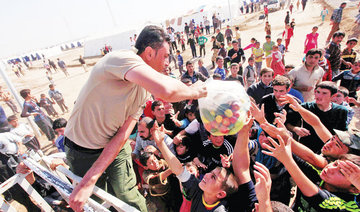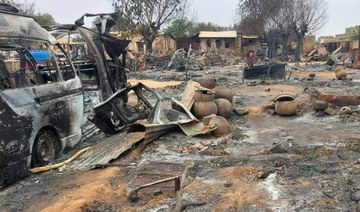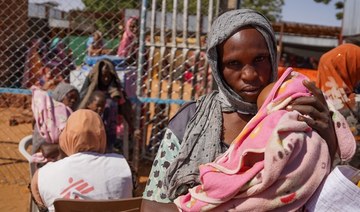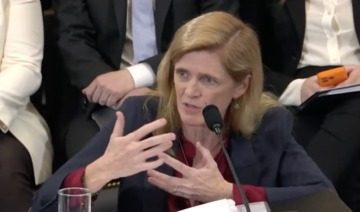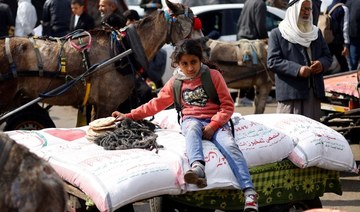BAGHDAD: Iraqi Kurdish leader Masoud Barzani, the driving force behind last month’s independence vote, finds himself isolated at home and abroad weeks after he scored a major victory with a resounding “yes” at the polls.
He organized the Sept. 25 referendum in the autonomous Kurdish region of northern Iraq with much fanfare, despite domestic and international objections. But analysts say he miscalculated.
Weeks after the vote, central government forces launched a sweeping operation, reclaiming territory and oil fields in and around the disputed province of Kirkuk from Kurdish Peshmerga forces.
The loss of the oil fields, which provided income that would have been critical to an independent Kurdish state, sparked recriminations among Kurds.
Iraqi President Fuad Masum, a Kurdish member of a party long at odds with Barzani’s Kurdistan Democratic Party (KDP) who supported a UN-backed push for dialogue, said the independence referendum triggered the assault on Kirkuk.
Iraqi Kurdistan’s main opposition party, Goran, has called for talks with Baghdad and demanded that Barzani and his deputy Kosrat Rasul resign, saying they “no longer have any legitimacy.”
“The KDP is isolated within Kurdistan itself, in Iraq, regionally and increasingly internationally,” said Kirk Sowell, an analyst and publisher of Inside Iraqi Politics.
Sowell said that faced with staunch opposition both from Goran and from long-time rival the Patriotic Union of Kurdistan, the KDP’s “only hope is that Baghdad overreaches and loses international support.”
But he warned that the KDP “doesn’t have much leverage left” in negotiations.
The US, a key ally of both Baghdad and Kurdish forces in the battle against Daesh, opposed the non-binding referendum, as did several nations including Iraq’s neighbors Iran and Turkey.
Iraq’s supreme court ruled that the vote was unconstitutional.
Barzani, who saw a “yes” vote as a step closer toward the cherished dream of Kurdish statehood, campaigned relentlessly prior to the referendum but has since slipped out of view.
On Sept. 26, a day after the vote, he urged Iraqi Prime Minister Haider Al-Abadi to begin talks on the issues dividing them, but the two sides remain wide apart. Al-Abadi has vowed to keep Iraqi unity intact and world powers appear to support his view.
“Barzani will now have to reconsider his maximalist attitude and reopen channels of negotiation,” Karim Bitar of the Paris-based Institute of International and Strategic Affairs told AFP.
“The US and the entire international community, with the notable exception of Israel, remains committed and attached to Iraq’s unity and territorial integrity,” he said.
The son of iconic Kurdish nationalist leader Mulla Mustafa Barzani and head of the KDP since 1979, Barzani has long been the face of demands for Kurdish self-determination.
Born on Aug. 16, 1946, in Mahabad, capital of a Kurdish republic declared by his father amid unrest in Iran following WWII, Barzani joined the fight for an independent Kurdistan as a teenager.
To this day he wears the garb of a Peshmerga fighter: Baggy khaki pants and shirt, a traditional sash and a checkered white-and-red scarf rolled around his head as a turban.
“Barzani has made strategic decisions for years based on a narrow circle of advisors, not through a democratic process,” Sowell said. “It appears... that Barzani is surrounded by people who just tell him what he wants to hear.”
Many Kurds believe that two men — former Iraqi Foreign Minister Hoshyar Zebari and Kirkuk Gov. Najm Eddine Karim — were behind Barzani’s decision to hold the referendum.
Kurdish affairs analyst Mutlu Civiroglu said the independence vote backfired and isolated Barzani because the Kurdish leader “misinterpreted” messages from Washington and Ankara.
Barzani believed both allies would support his march towards independence and failed to read between the lines, Civiroglu said.
The US was “very clear in supporting a united Iraq in which Kurds play a balancing role,” he said.
Turkey, home to a large Kurdish minority, saw the vote as a threat to its own unity, he added.
“Barzani could not read the position of the US in regards to Iraq and misinterpreted the messages” as support for his move toward independence, he said.
“He heavily relied on good relations with Turkey.”
Bitar said a “false vision of Iraq as a mere mosaic of ethnic and sectarian identities” had been reinforced since the US invasion of 2003.
“There has been a common and unfortunate tendency among many analysts and policymakers to underestimate the strength of Iraqi nationalism,” he said.
“To paraphrase Mark Twain, we could say that events of the past few days indicate that reports of Iraq’s death may have been greatly exaggerated.”
Barzani isolated by his drive for Kurdish independence
Barzani isolated by his drive for Kurdish independence
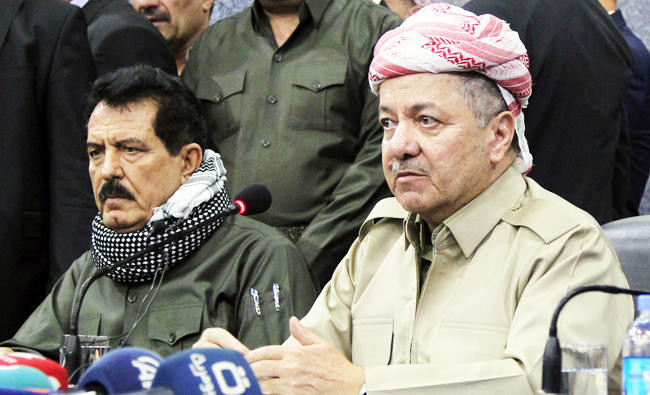
UN official warns famine in northern Gaza is already ‘full-blown’
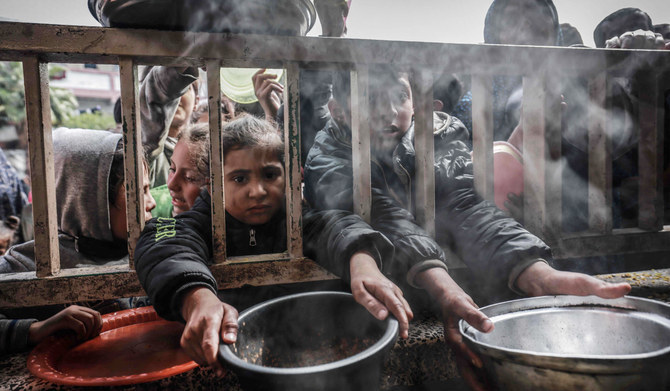
- Israel has killed more than 34,000 Palestinians since Oct. 7 attacks by Hamas
- There was no immediate comment from Israel, which controls entrance into Gaza
WASHINGTON: A top UN official said Friday that hard-hit northern Gaza was now in “full-blown famine” after more than six months of war between Israel and Hamas and severe Israeli restrictions on food deliveries to the Palestinian territory.
Cindy McCain, the American director of the UN World Food Program, became the most prominent international official so far to declare that trapped civilians in the most cut-off part of Gaza had gone over the brink into famine.
“It’s horror,” McCain told NBC’s “Meet the Press” in an interview to air Sunday. “There is famine — full-blown famine — in the north, and it’s moving its way south.”
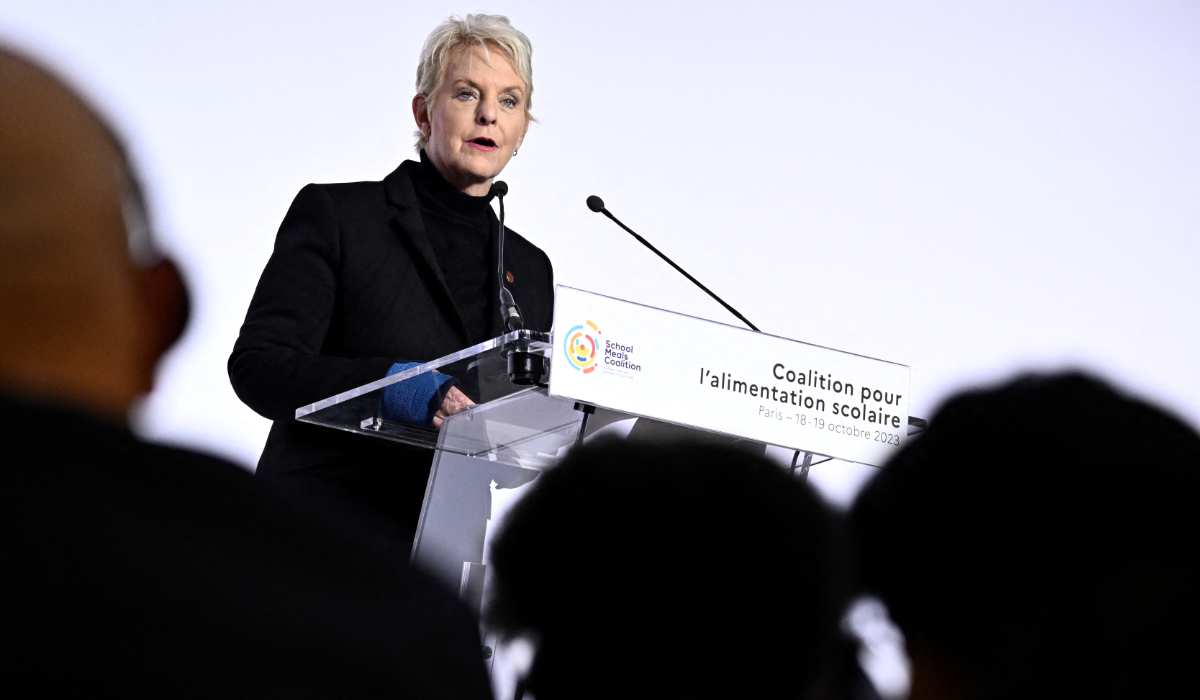
She said a ceasefire and a greatly increased flow of aid through land and sea routes was essential to confronting the growing humanitarian catastrophe in Gaza, home to 2.3 million people.
There was no immediate comment from Israel, which controls entrance into Gaza and says it is beginning to allow in more food and other humanitarian aid through land crossings.
The panel that serves as the internationally recognized monitor for food crises said earlier this year that northern Gaza was on the brink of famine and likely to experience it this month. The next update will not come before this summer.
One of the US Agency for International Development’s humanitarian officials in Gaza told The Associated Press that on-the-ground preparations for a new US-led sea route were on track to bring in more food — including treatment for hundreds of thousands of starving children — by early or mid-May. That’s when the American military expects to finish building a floating pier to receive the shipments.
Ramping up the delivery of aid on the planned US-backed sea route will be gradual as aid groups test the distribution and security arrangements for relief workers, the USAID official said.
The official spoke on condition of anonymity over security concerns for work done in a conflict zone. They were some of the agency’s first comments on the status of preparations for the Biden administration’s $320 million Gaza pier project, for which USAID is helping coordinate on-the-ground security and distribution.
At a factory in rural Georgia on Friday, USAID Administrator Samantha Power pointed to the food crises in Gaza and other parts of the world as she announced a $200 million investment aimed at increasing production of emergency nutritional paste for starving children under 5.
Power spoke to factory workers, peanut farmers and local dignitaries sitting among pallets of the paste at the Mana nonprofit in Fitzgerald. It is one of two factories in the US that produces the nutritional food, which is used in clinical settings and made from ground peanuts, powdered milk, sugar and oil, ready to eat in plastic pouches resembling large ketchup packets.
“This effort, this vision meets the moment,” Power said. “And it could not be more timely, more necessary or more important.”
Under pressure from the US and others, Israeli officials in recent weeks have begun slowly reopening some border crossings for relief shipments.
But aid coming through the sea route, once it’s operational, still will serve only a fraction — half a million people — of those who need help in Gaza. Aid organizations including USAID stress that getting more aid through border crossings is essential to staving off famine.
Children under 5 are among the first to die when wars, droughts or other disasters curtail food. Hospital officials in northern Gaza reported the first deaths from hunger in early March and said most of the dead were children.
Power said the UN has called for 400 metric tons of the nutritional paste “in light of the severe hunger that is pervading across Gaza right now, and the severe, acute humanitarian crisis.” USAID expects to provide a quarter of that, she said.
Globally, she said at the Georgia factory, the treatment made there “will save untold lives, millions of lives.”
USAID is coordinating with the World Food Program and other humanitarian partners and governments on security and distribution for the pier project, while US military forces finish building it. President Joe Biden, under pressure to do more to ease the humanitarian catastrophe in Gaza as the US provides military support for Israel, announced the project in early March.
US Central Command said in a statement Friday that offshore assembly of the floating pier has been temporarily paused due to high winds and sea swells, which caused unsafe conditions for soldiers. The partially built pier and the military vessels involved have gone to Israel’s Port of Ashdod, where the work will continue.
A US official said the high seas will delay the installation for several days, possibly until later next week. The official, who spoke on condition of anonymity to discuss operation details, said the pause could last longer if the bad weather continues because military personnel and divers have to get into the water for the final installation.
The struggles this week with the first aid delivery through a newly reopened land corridor into north Gaza underscored the uncertainty about security and the danger still facing relief workers. Israeli settlers blocked the convoy before it crossed Wednesday. Once inside Gaza, the convoy was commandeered by Hamas militants, before UN officials reclaimed it.
In Gaza, the nutritional treatment for starving children is most urgently needed in the northern part of the Palestinian territory. Civilians have been cut off from most aid supplies, bombarded by Israeli airstrikes and driven into hiding by fighting.
Acute malnutrition rates there among children under 5 have surged from 1 percent before the war to 30 percent five months later, the USAID official said. The official called it the fastest such climb in hunger in recent history, more than in grave conflicts and food shortages in Somalia or South Sudan.
One of the few medical facilities still operating in northern Gaza, Kamal Adwan hospital, is besieged by parents bringing in thousands of children with malnutrition for treatment, the official said. Aid officials believe many more starving children remain unseen and in need, with families unable to bring them through fighting and checkpoints for care.
Saving the gravely malnourished children in particular requires both greatly increased deliveries of aid and sustained calm in fighting, the official said, so that aid workers can set up treatment facilities around the territory and families can safely bring children in for the sustained treatment needed.
The UN warns Sudan’s warring parties that Darfur risks starvation and death if aid is not allowed in
The UN warns Sudan’s warring parties that Darfur risks starvation and death if aid is not allowed in
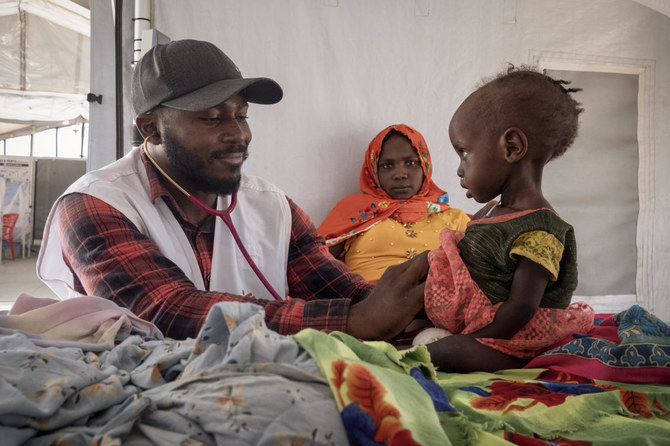
- At least 1.7 million people in Darfur were experiencing emergency levels of hunger in December
- Sudan plunged into chaos in mid-April 2023, when long-simmering tensions between the military and the paramilitary forces broke out into street battles
UNITED NATIONS: The United Nations food agency warned Sudan’s warring parties Friday that there is a serious risk of widespread starvation and death in Darfur and elsewhere in Sudan if they don’t allow humanitarian aid into the vast western region.
Leni Kinzli, the World Food Programme’s regional spokesperson, said at least 1.7 million people in Darfur were experiencing emergency levels of hunger in December, and the number “is expected to be much higher today.”
“Our calls for humanitarian access to conflict hotspots in Sudan have never been more critical,” she told a virtual UN press conference from Nairobi.
Sudan plunged into chaos in mid-April 2023, when long-simmering tensions between its military led by Gen. Abdel Fattah Burhan, and the paramilitary Rapid Support Forces commanded by Mohammed Hamdan Dagalo, broke out into street battles in the capital, Khartoum. Fighting has spread to other parts of the country, especially urban areas and the Darfur region.
The paramilitary forces, known as the RSF, have gained control of most of Darfur and are besieging El Fasher, the only capital in Darfur they don’t hold, where some 500,000 civilians had taken refuge.
Kinzli said WFP’s partners on the ground report that the situation in El Fasher is “extremely dire” and it’s difficult for civilians wanting to flee the reported RSF bombings and shelling to leave.
She said the violence in El Fasher and surrounding North Darfur is exacerbating the critical humanitarian needs in the entire Darfur region, where crop production for staple cereals like wheat, sorghum and millet is 78 percent less than the five-year average.
On top of the impact of escalating violence, Kinzli said, “WFP is concerned that hunger will increase dramatically as the lean season between harvests sets in and people run out of food.” She said a farmer in El Fasher recently told her that her family had already run out of food stocks and is living day-to-day, an indication that the “lean season,” which usually starts in May, started earlier.
Kinzli said she received photos earlier Friday from colleagues on the ground of severely malnourished children in a camp for displaced people in Central Darfur, as well as older people “who have nothing left but skin and bones.”
“Recent reports from our partners indicate that 20 children have died in recent weeks of malnutrition in that IDP camp,” she said.
“People are resorting to consuming grass and peanut shells,” Kinzli said. “And if assistance doesn’t reach them soon, we risk witnessing widespread starvation and death in Darfur and across other conflict-affected areas in Sudan.”
Kinzli called for “a concerted diplomatic effort by the international community to push the warring parties to provide access and safety guarantees” for humanitarian staff and convoys.
“One year of this devastating conflict in Sudan has created an unprecedented hunger catastrophe and threatens to ignite the world’s largest hunger crisis,” she warned. “With almost 28 million people facing food insecurity across Sudan, South Sudan and Chad, the conflict is spilling over and exacerbating the challenges that we’ve already been facing over the last year.”
In March, Sudanese authorities revoked WFP’s permission to deliver aid from neighboring Chad to West Darfur and Central Darfur from the town of Adre, saying that crossing had been used to transfer weapons to the RSF. Kinzli said restrictions from Sudanese authorities in Port Sudan are also preventing WFP from transporting aid via Adre.
Sudanese authorities approved the delivery of aid from the Chadian town of Tina to North Darfur, but Kinzli said WFP can no longer use that route for security reasons because it goes directly into besieged El Fasher.
On Thursday, gunmen in South Darfur killed two drivers for the International Committee of the Red Cross and injured three ICRC staff members. On Friday, UN humanitarian chief Martin Griffith called the killing of aid works “unconscionable.”
Kinzli said the fighting “and endless bureaucratic hurdles” have prevented WFP from delivering aid to over 700,000 people in Darfur ahead of the rainy season when many roads become impassable.
“WFP currently has 8,000 tons of food supplies ready to move in Chad, ready to transport, but is unable to do so because of these constraints,” she said.
“WFP urgently requires unrestricted access and security guarantees to deliver assistance,” she said. “And we must be able to use the Adre border crossing, and move assistance across front lines from Port Sudan in the east to Darfur so we can reach people in this desperate region.”
Hamas ‘only thing standing between the people of Gaza and a ceasefire’: Blinken
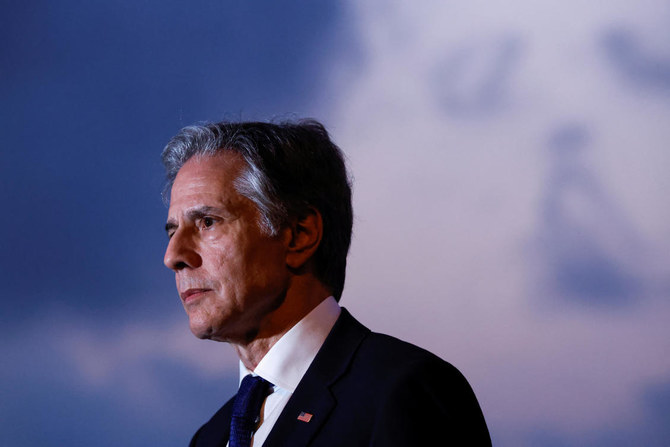
- ‘We wait to see whether, in effect, they can take yes for an answer on the ceasefire and release of hostages’
- But official says US cannot support a major military operation going into Rafah
“We wait to see whether, in effect, they can take yes for an answer on the ceasefire and release of hostages,” Blinken said late Friday.
“The reality in this moment is the only thing standing between the people of Gaza and a ceasefire is Hamas.”
Blinken pointed to difficulties in negotiating with Hamas, which the United States considers a terrorist group and does not engage with directly and which Israel has vowed to eliminate.
“The leaders of Hamas that we’re indirectly engaged with — through the Qataris, through the Egyptians — are, of course, living outside of Gaza,” Blinken said.
“The ultimate decision-makers are the folks who are actually in Gaza itself with whom none of us have direct contact.”
Blinken was addressing a dinner at the McCain Institute’s Sedona Forum in Arizona two days after meeting Israeli Prime Minister Benjamin Netanyahu and other top leaders on his latest visit to the Middle East.
Ahead of his talks with Blinken, Netanyahu vowed to push ahead with an assault on the southern Gaza city of Rafah to root out Hamas regardless of the outcome of negotiations for a temporary ceasefire that would involve the release of hostages.
President Joe Biden’s administration has repeatedly warned Netanyahu’s government against moving on Rafah, where some 1.4 million Palestinians have taken shelter after fleeing the Israeli assault in response to the October 7 attack by Hamas.
Blinken said that Israel, which counts on the United States for military and diplomatic support, has yet to present “a credible plan to genuinely protect the civilians who are in harm’s way” in Rafah.
“Absent such a plan, we can’t support a major military operation going into Rafah because the damage it would do is beyond what’s acceptable,” Blinken said.
France condemns attack on Red Cross in Sudan
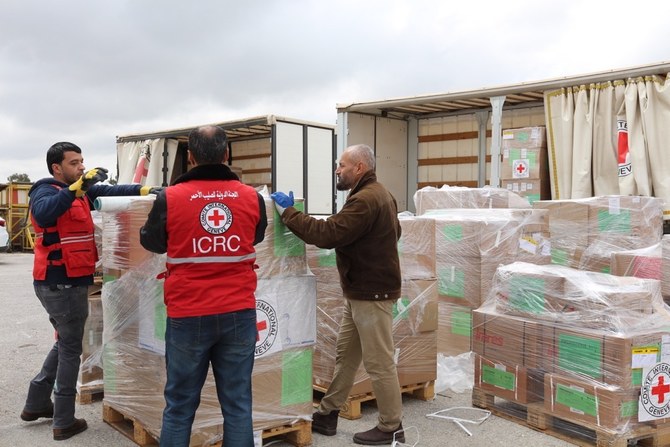
PARIS: France on Friday condemned “in the strongest terms” an attack on an International Committee of the Red Cross convoy in war-torn Sudan that killed two staff and injured three others.
“France calls on all parties to the conflict to respect their obligations under international humanitarian law, which obliges them to protect humanitarian and health staff and guarantee complete, safe and unhindered humanitarian access,” said French foreign ministry spokesman Christophe Lemoine.
The ICRC said gunmen killed two drivers and injured three staff in South Darfur on Thursday as they returned from a humanitarian mission.
A brutal conflict between the Sudanese army led by General Abdel Fattah Al-Burhan and the paramilitary Rapid Support Forces of his ex-deputy Mohamed Hamdan Dagalo has torn the country apart for more than a year.
The war has killed tens of thousands of people and forced millions more to flee their homes in what the United Nations has called the “largest displacement crisis in the world.”
It has also triggered acute food shortages and a humanitarian crisis that has left the northeast African country’s people at risk of starvation.
UN official warns that famine in northern Gaza is already ‘full-blown’

- Israel has killed more than 34,000 Palestinians, according to Gaza’s Health Ministry
- The panel that serves as the internationally recognized monitor for food crises said earlier this year that northern Gaza was on the brink of famine and likely to experience it this month
WASHINGTON: A top UN official said Friday that hard-hit northern Gaza was now in “full-blown famine” after more than six months of war between Israel and Hamas and severe Israeli restrictions on food deliveries to the Palestinian territory.
Cindy McCain, the American director of the UN World Food Program, became the most prominent international official so far to declare that trapped civilians in the most cut-off part of Gaza had gone over the brink into famine.
“It’s horror,” McCain told NBC’s “Meet the Press” in an interview to air Sunday. “There is famine — full-blown famine — in the north, and it’s moving its way south.”

She said a ceasefire and a greatly increased flow of aid through land and sea routes was essential to confronting the growing humanitarian catastrophe in Gaza, home to 2.3 million people.
There was no immediate comment from Israel, which controls entrance into Gaza and says it is beginning to allow in more food and other humanitarian aid through land crossings.
The panel that serves as the internationally recognized monitor for food crises said earlier this year that northern Gaza was on the brink of famine and likely to experience it this month. The next update will not come before this summer.
One of the US Agency for International Development’s humanitarian officials in Gaza told The Associated Press that on-the-ground preparations for a new US-led sea route were on track to bring in more food — including treatment for hundreds of thousands of starving children — by early or mid-May. That’s when the American military expects to finish building a floating pier to receive the shipments.
Ramping up the delivery of aid on the planned US-backed sea route will be gradual as aid groups test the distribution and security arrangements for relief workers, the USAID official said.
The official spoke on condition of anonymity over security concerns for work done in a conflict zone. They were some of the agency’s first comments on the status of preparations for the Biden administration’s $320 million Gaza pier project, for which USAID is helping coordinate on-the-ground security and distribution.
At a factory in rural Georgia on Friday, USAID Administrator Samantha Power pointed to the food crises in Gaza and other parts of the world as she announced a $200 million investment aimed at increasing production of emergency nutritional paste for starving children under 5.
Power spoke to factory workers, peanut farmers and local dignitaries sitting among pallets of the paste at the Mana nonprofit in Fitzgerald. It is one of two factories in the US that produces the nutritional food, which is used in clinical settings and made from ground peanuts, powdered milk, sugar and oil, ready to eat in plastic pouches resembling large ketchup packets.
“This effort, this vision meets the moment,” Power said. “And it could not be more timely, more necessary or more important.”
Under pressure from the US and others, Israeli officials in recent weeks have begun slowly reopening some border crossings for relief shipments.
But aid coming through the sea route, once it’s operational, still will serve only a fraction — half a million people — of those who need help in Gaza. Aid organizations including USAID stress that getting more aid through border crossings is essential to staving off famine.
Children under 5 are among the first to die when wars, droughts or other disasters curtail food. Hospital officials in northern Gaza reported the first deaths from hunger in early March and said most of the dead were children.
Power said the UN has called for 400 metric tons of the nutritional paste “in light of the severe hunger that is pervading across Gaza right now, and the severe, acute humanitarian crisis.” USAID expects to provide a quarter of that, she said.
Globally, she said at the Georgia factory, the treatment made there “will save untold lives, millions of lives.”
USAID is coordinating with the World Food Program and other humanitarian partners and governments on security and distribution for the pier project, while US military forces finish building it. President Joe Biden, under pressure to do more to ease the humanitarian catastrophe in Gaza as the US provides military support for Israel, announced the project in early March.
US Central Command said in a statement Friday that offshore assembly of the floating pier has been temporarily paused due to high winds and sea swells, which caused unsafe conditions for soldiers. The partially built pier and the military vessels involved have gone to Israel’s Port of Ashdod, where the work will continue.
A US official said the high seas will delay the installation for several days, possibly until later next week. The official, who spoke on condition of anonymity to discuss operation details, said the pause could last longer if the bad weather continues because military personnel and divers have to get into the water for the final installation.
The struggles this week with the first aid delivery through a newly reopened land corridor into north Gaza underscored the uncertainty about security and the danger still facing relief workers. Israeli settlers blocked the convoy before it crossed Wednesday. Once inside Gaza, the convoy was commandeered by Hamas militants, before UN officials reclaimed it.
In Gaza, the nutritional treatment for starving children is most urgently needed in the northern part of the Palestinian territory. Civilians have been cut off from most aid supplies, bombarded by Israeli airstrikes and driven into hiding by fighting.
Acute malnutrition rates there among children under 5 have surged from 1 percent before the war to 30 percent five months later, the USAID official said. The official called it the fastest such climb in hunger in recent history, more than in grave conflicts and food shortages in Somalia or South Sudan.
One of the few medical facilities still operating in northern Gaza, Kamal Adwan hospital, is besieged by parents bringing in thousands of children with malnutrition for treatment, the official said. Aid officials believe many more starving children remain unseen and in need, with families unable to bring them through fighting and checkpoints for care.
Saving the gravely malnourished children in particular requires both greatly increased deliveries of aid and sustained calm in fighting, the official said, so that aid workers can set up treatment facilities around the territory and families can safely bring children in for the sustained treatment needed.


